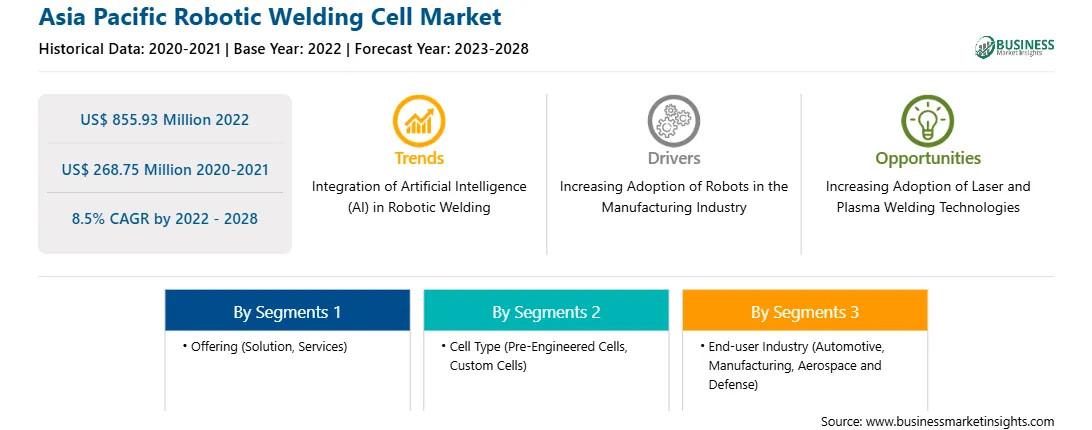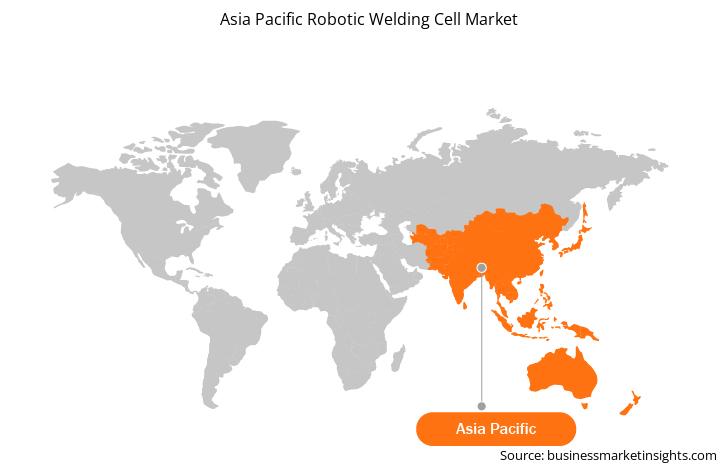亚太地区机器人焊接单元市场预测至 2028 年 - 通过提供(解决方案和服务)、单元类型(预设计单元和定制单元)以及最终用户行业(汽车、制造、航空航天和国防)进行 COVID-19 影响和区域分析)
No. of Pages: 104 | Report Code: BMIRE00027459 | Category: Manufacturing and Construction
No. of Pages: 104 | Report Code: BMIRE00027459 | Category: Manufacturing and Construction
实施协作机器人以弥补技能差距
协作机器人或协作机器人旨在在乏味、沉闷和危险的环境中与人类安全地一起工作。与传统工业机器人在围栏设施中工作以避免与人类接近不同,协作机器人与人类劳动力一起在共享工作空间中运行。传统工业机器人长期以来一直让制造商能够利用自动化并弥补劳动力短缺,但它们通常被设计用来执行特定任务。此外,它们缺乏认知能力,因此人类需要根据新情况重新编程其操作。相比之下,协作机器人不需要笨重的预编程执行器来驱动它们。协作机器人的动作由计算机控制的操作员指挥,例如由人类监控的机械臂。因此,协作机器人促进了工作场所中有效的人机协作。经过编程,协作机器人可以在工厂环境中执行各种任务,例如处理材料、组装物品、码垛、包装、贴标签、检查产品质量、焊接、压装、驱动螺钉和螺母以及管理机器。当协作机器人执行这些令人麻木的任务时,人类工人可以专注于需要技能和推理的任务。协作机器人的所有优势将在预测期内推动机器人焊接单元市场的增长。
市场概览
亚太地区的机器人焊接单元市场分为中国、印度、日本、澳大利亚、韩国和亚太地区其他地区。由于对流程自动化、提高效率和生产力以及减少人为错误的需求不断增长,机器人技术在亚太地区得到越来越多的采用。各种汽车、医疗保健、国防和航空航天行业都采用机器人技术来实现流程自动化和高效的资源管理。由于汽车工业占主导地位且制造单位成本低廉,工业机器人主要在亚太地区使用。该地区人口老龄化的加剧也推动了中国和日本等国家对服务机器人的需求。机器人在娱乐、教育和医疗保健等不同行业中的应用不断增加,进一步补充了该市场的增长。限制市场增长的因素包括高初始投资和严格的安全法规。群体机器人、云机器人和仿生学等技术的进步将为该地区的市场提供大量增长机会。
亚太机器人焊接单元市场细分
亚太机器人焊接单元市场细分为产品、单元类型、最终用户和国家/地区。
根据产品提供,市场分为解决方案和服务。解决方案领域在 2022 年占据了最大的市场份额。根据电池类型,市场分为预设计电池和定制电池。预工程细分市场在 2022 年占据最大的市场份额。根据最终用户,亚太机器人焊接单元市场分为汽车、制造、航空航天和国防。 2022 年,制造业占据最大的市场份额。根据国家/地区,市场分为澳大利亚、中国、印度、日本、韩国和亚太地区其他地区。 2022 年,中国在市场份额中占据主导地位。林肯电气公司;库卡股份公司;川崎重工业有限公司; Zeman Bauelemente Produktionsgesellschaft mbH;和 Phoenix Industrial Solutions 是该地区机器人焊接单元市场的领先公司。
Strategic insights for Asia Pacific Robotic Welding Cell involve closely monitoring industry trends, consumer behaviours, and competitor actions to identify opportunities for growth. By leveraging data analytics, businesses can anticipate market shifts and make informed decisions that align with evolving customer needs. Understanding these dynamics helps companies adjust their strategies proactively, enhance customer engagement, and strengthen their competitive edge. Building strong relationships with stakeholders and staying agile in response to changes ensures long-term success in any market.

| Report Attribute | Details |
|---|---|
| Market size in 2022 | US$ 855.93 Million |
| Market Size by 2028 | US$ 268.75 Million |
| Global CAGR (2022 - 2028) | 8.5% |
| Historical Data | 2020-2021 |
| Forecast period | 2023-2028 |
| Segments Covered |
By 产品
|
| Regions and Countries Covered | 亚太地区
|
| Market leaders and key company profiles |
The regional scope of Asia Pacific Robotic Welding Cell refers to the geographical area in which a business operates and competes. Understanding regional nuances, such as local consumer preferences, economic conditions, and regulatory environments, is crucial for tailoring strategies to specific markets. Businesses can expand their reach by identifying underserved regions or adapting their offerings to meet regional demands. A clear regional focus allows for more effective resource allocation, targeted marketing, and better positioning against local competitors, ultimately driving growth in those specific areas.

The Asia Pacific Robotic Welding Cell Market is valued at US$ 855.93 Million in 2022, it is projected to reach US$ 268.75 Million by 2028.
As per our report Asia Pacific Robotic Welding Cell Market, the market size is valued at US$ 855.93 Million in 2022, projecting it to reach US$ 268.75 Million by 2028. This translates to a CAGR of approximately 8.5% during the forecast period.
The Asia Pacific Robotic Welding Cell Market report typically cover these key segments-
The historic period, base year, and forecast period can vary slightly depending on the specific market research report. However, for the Asia Pacific Robotic Welding Cell Market report:
The Asia Pacific Robotic Welding Cell Market is populated by several key players, each contributing to its growth and innovation. Some of the major players include:
The Asia Pacific Robotic Welding Cell Market report is valuable for diverse stakeholders, including:
Essentially, anyone involved in or considering involvement in the Asia Pacific Robotic Welding Cell Market value chain can benefit from the information contained in a comprehensive market report.